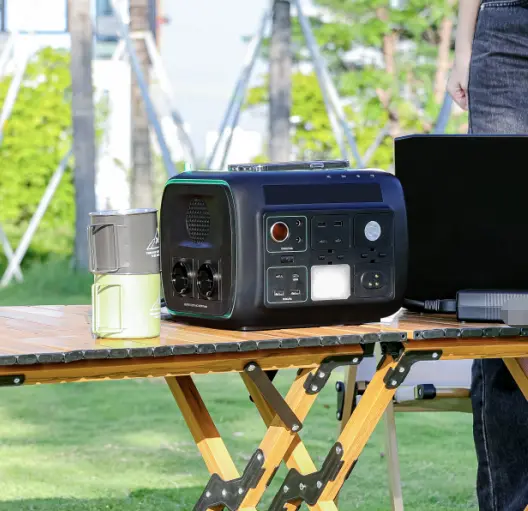The Portable Power Station Battery has emerged as an essential component of the portable power station, a highly valued gadget for modern outdoor adventures, emergency preparedness, and even day-to-day tasks where reliable power is needed. With its ability to store and supply power for various devices, the longevity of the Portable Power Station Battery becomes critically important. A battery with a longer life ensures that your devices are always powered, enhancing the overall reliability of your power station. Therefore, it’s essential to understand how to maximize your Portable Power Station Battery’s life to reap the most benefits from it.
Understanding Your Portable Power Station’s Battery
The power unit of your portable power station is essentially a battery – a device that stores energy and releases it as needed. Understanding the intricacies of how this battery functions can provide valuable insights into how you can maximize its life and efficiency.
Explanation of how the battery functions
Every portable power station uses a particular type of battery, the most common being lithium-ion batteries and lead-acid batteries. These batteries work on the principle of a chemical reaction where an imbalance of electrons is created between the two ends of the battery, known as the anode and the cathode. When a device is connected to the battery, it completes the circuit, and electrons flow from the anode to the cathode, providing the electrical energy that powers the device.
The impact of usage habits on battery life
However, the efficiency and longevity of the battery life are not just dependent on the chemical reaction occurring inside. Your usage habits also play a significant role in determining how long your portable power station’s battery will last. These usage habits can involve several factors, such as the types of devices you’re powering, how long you’re running those devices, and how frequently you’re charging and discharging the battery.
For instance, regularly depleting the battery to its lowest possible charge before recharging it (known as a deep discharge) can significantly decrease a lithium-ion battery’s lifespan. Similarly, keeping a lead-acid battery consistently at full charge may also reduce its life.
Overloading the power station beyond its capacity can also affect battery life. Each portable power station is designed to handle a certain wattage. If you connect devices that exceed this wattage, the battery may overheat, affecting its performance and lifespan. Also, frequently using high-wattage appliances can result in more rapid battery drain, reducing the total number of charge cycles the battery can handle before its performance begins to drop.
Heat can also influence battery lifespan. Batteries tend to discharge faster in hot environments. Therefore, storing your portable power station in a cool, dry place when not in use can help to maintain the battery life.
Lastly, how often and how you recharge your power station can impact battery life. Consistently charging the battery to full and then draining it completely can strain the battery and reduce its lifespan. Conversely, maintaining the charge between around 20% and 80% can extend battery life, a principle known as the 20-80 rule.
Optimal Charging Practices
Proper charging is a crucial aspect of maximizing your portable power station’s battery life. Optimal charging practices will not only help your battery last longer but also ensure that it operates at peak performance.
Importance of following manufacturer’s instructions
Always begin by following the manufacturer’s instructions regarding charging procedures. Different models and brands may have specific requirements concerning the kind of power source you can use for charging, the acceptable charging temperature range, and so on. Ignoring these guidelines can potentially damage the battery and shorten its lifespan.
Avoiding overcharging, ideal charging temperature, etc.
With advancements in technology, we’ve seen a significant improvement in battery management systems. Nowadays, users don’t have to be overly concerned about overcharging or discharging, as these systems have been designed to handle these issues automatically. Most modern portable power stations come with an auto shut-off feature that stops the charging process once the battery reaches full capacity, mitigating the risk of overcharging.
Despite this technological advantage, it remains a good practice not to leave your power station plugged in longer than necessary after it reaches full charge. This is because excessive heat generated during prolonged charging, even if not overcharging, can still contribute to accelerated battery wear.
The principle known as the 20-80 rule is also worth noting. While the automated systems effectively manage charge levels, following this rule can further help in prolonging the battery life. This rule suggests maintaining the battery charge level between 20% and 80% as both a complete discharge (falling below 20%) and a full charge (going above 80%) can potentially stress the battery.
Furthermore, the temperature when charging your portable power station is also a factor to consider. Even with advanced systems in place, extreme cold or hot conditions can affect the battery’s ability to hold a charge. A moderate room temperature – usually between 20°C and 25°C (68°F to 77°F) – is ideal for charging.
Usage Tips to Extend Battery Life
How you use your portable power station can significantly affect its battery life. Managing power demands smartly by spreading usage over time and not running your station at full load can extend battery life. Use energy-efficient devices and unplug them once fully charged. By reducing the power drawn at any one time, the battery lasts longer, providing a more durable and reliable power source for all your needs. This careful and considered usage is an easy but effective strategy for maximizing your portable power station’s battery life.
Maintenance and Care Tips
Proper maintenance and care are equally important as charging and usage habits for extending your portable power station’s battery life. Regular check-ups to ensure your power station is in good working condition can prevent unnecessary strain on the battery.
The role of regular maintenance in prolonging battery life
Keep your power station clean, and dust-free to prevent overheating and promote efficient operation. Use a soft, dry cloth to wipe the exterior and avoid using any corrosive cleaning agents that might harm the station’s components.
Specific care tips
Storage conditions also matter. If you’re not using the power station for extended periods, store it in a cool, dry place away from direct sunlight or extreme temperatures. It’s also recommended to charge the battery to around 50-60% before storage, as fully charged or fully drained batteries can degrade faster.
Check the battery status regularly, even when not in use. Lithium-ion batteries naturally discharge over time, and letting them sit discharged can negatively impact their lifespan. If not used regularly, top up the battery every few months.
Finally, follow the manufacturer’s instructions for maintenance. Some might offer additional tips specific to the model, so always keep the manual handy. By following these maintenance and care tips, you can significantly increase the lifespan of your portable power station’s battery, ensuring you always have a reliable power source when you need it.
When to Replace Your Battery
Recognizing the signs of a deteriorating battery and knowing when to replace it is vital for ensuring the safety and performance of your portable power station. Here are some common indicators that your battery might need replacement:
Reduced Run Time:
If your power station isn’t lasting as long as it used to on a full charge, your battery might be nearing the end of its life. However, consider other factors such as increased load or extreme temperatures, which could also affect run time.
Failure to Hold Charge:
If your battery discharges rapidly or doesn’t hold a charge at all, it could be a sign of significant wear and tear.
Swollen Battery:
A physical change, such as swelling or leakage in the battery, is a serious indicator that the battery needs to be replaced immediately.
Frequent Power Fluctuations:
If you’re noticing frequent voltage drops or power fluctuations, it might be a sign that your battery is not functioning optimally.
If you observe any of these signs, it’s time to consider replacing the battery. It’s crucial to follow safe replacement practices to avoid injury and potential damage to your portable power station.
Discussing the process of replacing the battery safely
Before proceeding with the replacement, make sure you have the right type of battery specified by the manufacturer. Misfit batteries can cause problems and might even damage the power station. Always disconnect the power station before replacing the battery to avoid electrical shock.
When removing the old battery, handle it carefully to prevent leakage or rupture. Dispose of the used battery responsibly, considering local regulations about battery disposal. Some places have specific recycling programs for batteries, which help in reducing environmental impact.
Once the new battery is in place, ensure all the connections are secure and properly fitted. After the replacement, keep an eye on the new battery’s performance for a few days to make sure it’s functioning correctly.
By staying vigilant for signs of a deteriorating battery and replacing it safely and promptly when necessary, you can ensure that your portable power station continues to provide reliable power when you need it.
Source: latestportablepower.com




